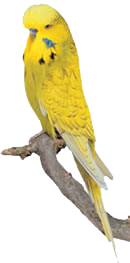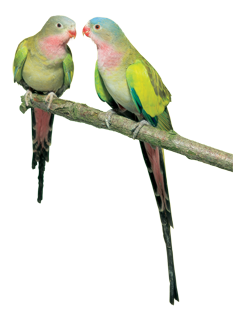Articles
Spring Growth
Spring is a time of great change for Mother Nature but did you know that it is also a time of great change for birds?
At this time of year, many species of bird undergo a moult. Moulting is a significant, but normal event in a bird's life and involves the shedding of its old feathers and the growth of new ones and this usually lasts for around six weeks.
Moulting is a process that should be allowed to run its course naturally, however there are a few things you can do to help ensure your bird's feather regeneration is as successful as it should be.
An impending moult usually begins with occasional feather-picking and preening. As time goes by, this habit will become more intense and the bird will become more and more concerned with its plumage. As the quills on the old feathers begin to loosen, your bird will pull them out in preparation for the new growth.
Moulting is a "true test" of the bird's nutritional state. Nutritional deficiencies are exposed probably more often during moulting than at any other time of the bird's life.
 To help sustain it through the moult, the bird must be healthy and have its body reserves well prepared. A good, healthy diet full of proteins, vitamins and minerals throughout winter will go a long way towards meeting these needs.
To help sustain it through the moult, the bird must be healthy and have its body reserves well prepared. A good, healthy diet full of proteins, vitamins and minerals throughout winter will go a long way towards meeting these needs.
A commercially prepared bird seed like TRILL™ will usually provide all the nutrition it needs before and during this time, however adding some (cooked) egg to the food will provide an extra protein boost if required.
The growth of hundreds of new feathers takes up an enormous amount of energy and sometimes physically weakens the bird, so plenty of rest will be required.
In the wild, a moulting bird will spend a lot of its time 'hidden and quiet' as its loss of feathers inhibits its ability to fly making it vulnerable to predators.
You can help make your bird feel more secure by keeping the cage in a quiet part of the house and covering part of the cage with a blanket. Most birds will require eight to 12 hours rest during this time.
While not all the feathers fall out during a moult, most birds are relatively 'naked' during this time and may need extra help to keep warm so remember to keep a careful eye on the room temperature.
The regrowth stage is fascinating with each new feather appearing wrapped in a protective keratin casing which must be removed by the bird before the feather can spread out.
With hundreds of new feathers being generated during the moult, birds must preen constantly. You may also notice a white flaking material (similar to dandruff) collecting on the floor of the cage during this time. This is in fact the residue of the keratin sheath.
